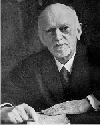The Greek (possibly a Hellenized Banylonian)
mathematician, Diophantus of Alexandria (circa 200/214-284/298 A.D.)
,
We know little about the life of Diophantus, except for an Algebraic Riddle quoted in The Greek Anthology.
To cite The Encyclopedia Brittanica, "Greek ANTHOLOGIA HELLENIKE, also called PALATINE ANTHOLOGY, a collection of Greek epigrams, songs, epitaphs, and rhetorical exercises that includes about 3,700 short poems, mostly written in elegiac couplets. Some of the poems were written as early as the 7th century BC, others as late as AD 1000....The literary value of the Anthology lies in the distinction and charm of perhaps one-sixth of the whole. For the rest, it preserves a good deal that is of historical interest; it illustrates the continuity of Greek literature for almost 2,000 years, because the latest inclusions in it are, in language, style, and feeling, not too different from the earliest inclusions. The Anthology also had a persistent and considerable influence on later literature."
Some of the passages in The Greek Anthology read like epitaphs on grave stones, as in the following:
"Ye children of the ox, how wrong of you to kill Hermonax, the straying baby boy. The poor child, in the innocence of his heart, went to you thinking you were bees, and you proved worse than vipers. Instead of giving him a dainty feast you drove your murderous stings into him, bitter bees, contrary in nature to your sweet gifts."
(The grave citations of The Greek Anthology inspired the American long poem, Spoon River Anthology, by Edgar Lee Masters.)
The passage about Diophantus presents (in translation) a Riddle about the phases of his life:
Let
In solving, the least common denominator of these numbers (6, 12, 7, 2) is 12 x 7 = 84. Then,
CHECKING (back to ARITHMETIC!): 14 + 7 + 12 + 5 + 42 + 4 = 21 + 17 + 46 = 38 + 46 = 84. ANSWER: 84 years of life. TAKE NOTE! The work of Diophantus appeared in his publication
labeled, in Latin translation, Arithmetica. While perusing a copy of this, the
great
Mathematicians have vied to prove this since that time -- and the failure HAVE OFTEN ADVANCED
MATHEMATICS! In 1995, a journal published a proof of Fermat's contention by the Princeton U.
mathematician, Mathematicians today study a vast and often difficult field of MATHEMATICS known as "Diophantine Analysis". The latter word can be misleading, since mathematicians often use "analysis" for "Differential and Integral Calculus", "Ordinary and Partial Differential Equations", and other fields requiring continuous tools, such as "limit processes". But this "Diophantine" subject deals with "the discrete" or "discontinuous", so is an extension of NUMALGEBRA.
DIOPHANTINE EQUATIONS: Let f(x1, x2, ..., xn) be a polynomial in x1, x2, ..., xn with INTEGER COEFFICIENTS. It is Diophantine IF SOLUTIONS MUST BE INTEGRAL.
Linear Example: 4x1 + 6x2 = 24. A solution is x1 = 3, x2 = 2. (For a LINEAR EQUATION, a1x1 + a2x2 + ... + anxn = b, to be INTEGRALLY SOLVABLE, b must BE DIVISIBLE BY gcd(a1, a2, ..., an) -- as you find in the above example, wherein gcd(4, 6) = 2 divides 12. (Linear Diophantine equations have been useful in modeling chemical crystals.) has been called "The Father of Algebra". But, as some one said about another subject, "Algebra has many fathers". al-Khwarizmi (cited in another file) could be called "The Islamic
Father of Algebra", so we'll call Diophantus "The Greek Father of Algebra". We also credit Diophantus with a vast field of Mathematics, which has found great application in Physics, for example, in Crystallography -- as we'll see below.
has been called "The Father of Algebra". But, as some one said about another subject, "Algebra has many fathers". al-Khwarizmi (cited in another file) could be called "The Islamic
Father of Algebra", so we'll call Diophantus "The Greek Father of Algebra". We also credit Diophantus with a vast field of Mathematics, which has found great application in Physics, for example, in Crystallography -- as we'll see below.
God granted him to be a boy for a sixth part of his life, and adding a twelfth part to this, He clothed his cheeks with down; He lit him the light of wedlock after a seventh part, and five years after his marriage He granted him a son. Alas! late-borne wretched child; after attaining the measure of half his father's life, chill Fate took him. After consoling his grief by this science of numbers for four years he ended his life.
 Pierre Fermat (1601-1665) wrote on the margin of the book that HE HAD A PROOF that the equation an + bn = cn, n = 1, 2, ..., has A SOLUTION IN INTEGERS a, b, c ONLY FOR n = 1 (simple addition) and n = 2 ("Pythagorean Formula") -- BUT HE DIDN'T HAVE ROOM TO WRITE IT DOWN.
Pierre Fermat (1601-1665) wrote on the margin of the book that HE HAD A PROOF that the equation an + bn = cn, n = 1, 2, ..., has A SOLUTION IN INTEGERS a, b, c ONLY FOR n = 1 (simple addition) and n = 2 ("Pythagorean Formula") -- BUT HE DIDN'T HAVE ROOM TO WRITE IT DOWN. Andrew Wiles, using very advanced methods.
Andrew Wiles, using very advanced methods.
 David Hilbert (1862-1943), gave a List of Problems to be Solved -- one
of which was A GENERAL SOLUTION FOR DIOPHANTINE EQUATIONS. Eventually, it was PROVEN THAT
NO SUCH GENERAL SOLUTION CAN EXIST!
David Hilbert (1862-1943), gave a List of Problems to be Solved -- one
of which was A GENERAL SOLUTION FOR DIOPHANTINE EQUATIONS. Eventually, it was PROVEN THAT
NO SUCH GENERAL SOLUTION CAN EXIST!